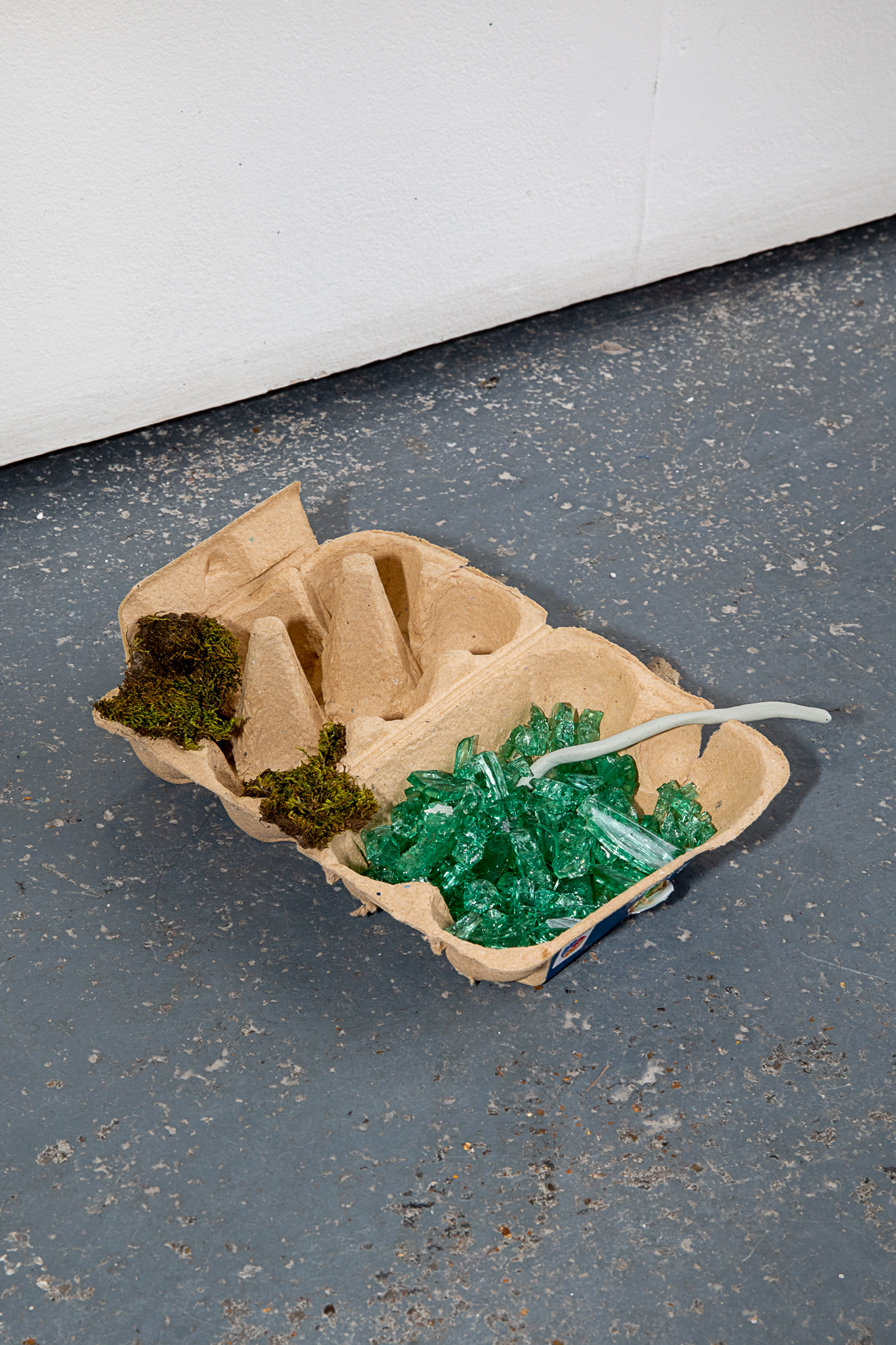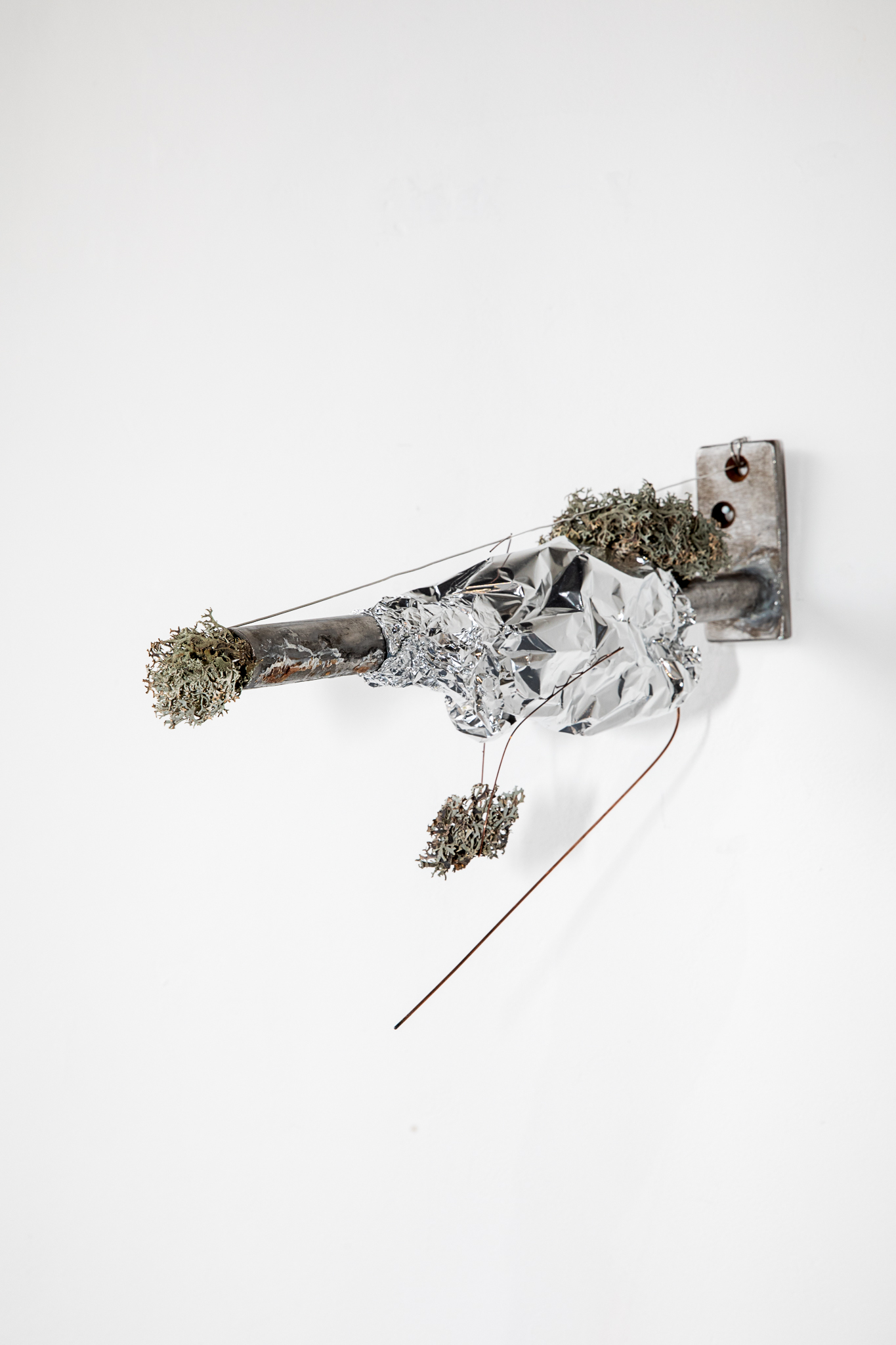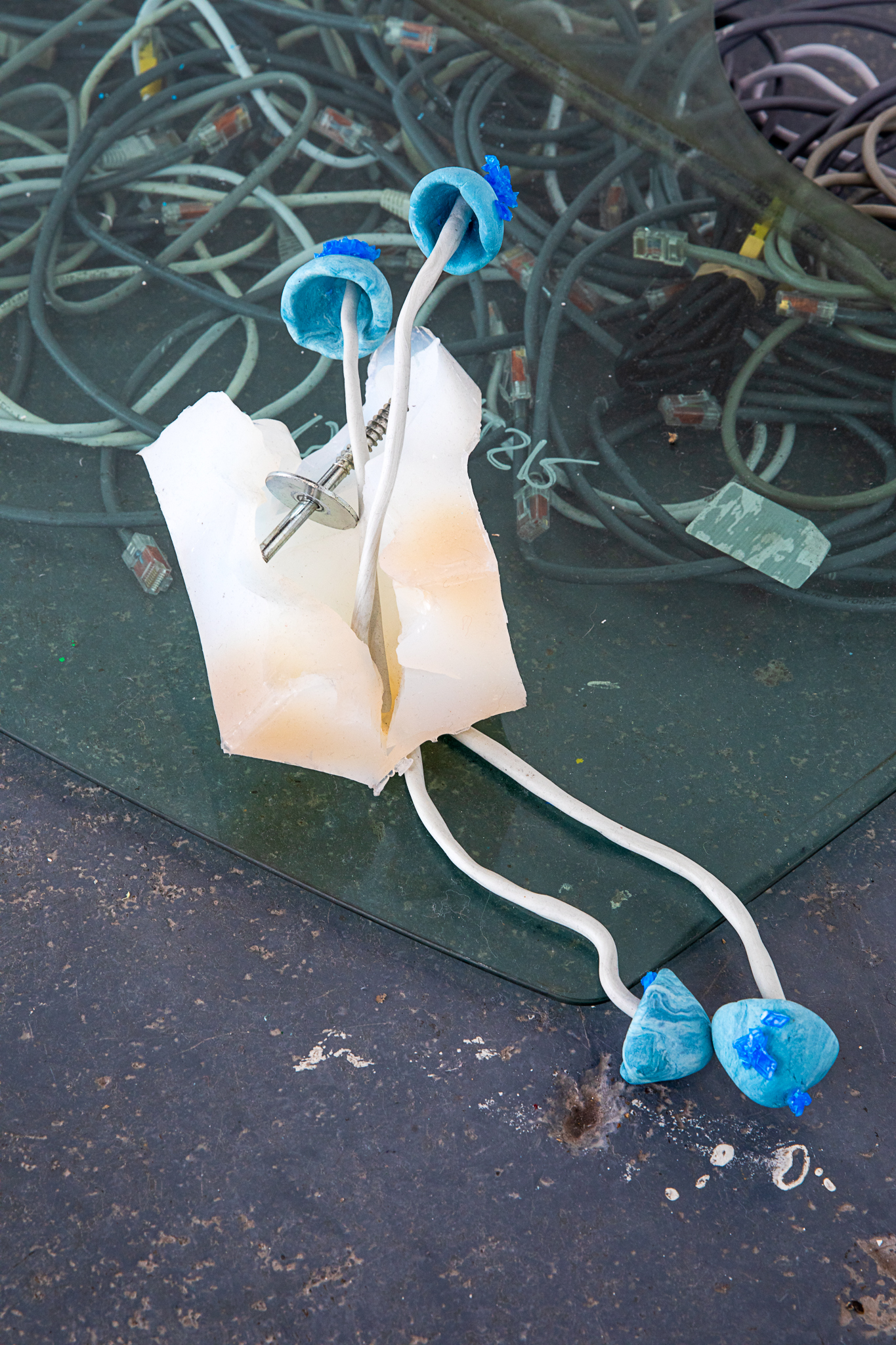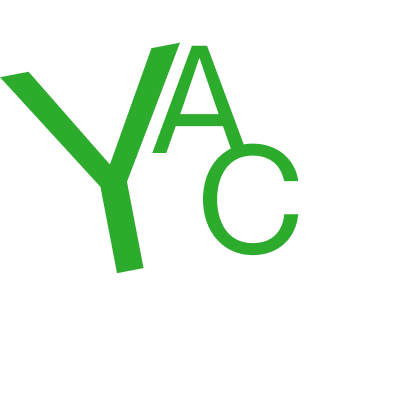Juliusz Grabianski & Anna Komitska
-
Published in October 2023
-
Juliusz: Okay, so where do we start?
Anna: We had an exhibition together in March, called Doomwashing.
Juliusz: Yes, it all started on a rooftop bar in Bulgaria last October. We went out for drinks after our opening in Sofia and somehow ended up in that bar, which was equally cursed and incredible. We drunkenly spoke about doing an exhibition together again, and then the morning after, I woke up in your mom's house, and immediately started looking at dates.

Doomwashing, installation view, Juliusz Grabianski and Anna Komitska, AMP Gallery, London, 2023
Anna: I almost thought that the cursed bar inspired the theme.
Juliusz: Definitely, the vibes were there from day one. At the time, I was thinking a lot about Francis Fukuyama’s essay “The End of History”. Written in 1989, just before the fall of the Berlin Wall, it makes a claim that because the ideological struggle between capitalism and communism ended, so has history. And because capitalism became pretty much universal at that point, humanity has achieved its final form of governance. Reading it in 2023, this sounds a bit absurd of course, but when you think how deeply the 20th century was shaped by the Cold War, it makes sense that you would feel like history had ended. I think the cultural impact of nuclear weapons is really fascinating, because it feels somehow parallel to the media narratives surrounding AI - both of these technologies are completely outside of our control, and yet influence our lives in a very direct way. And then as I was zoning out on Instagram a few weeks later, I saw the term ‘doomwashing’ coined by Morning.fyi, which instantly became the title of our show. They defined it as large brands using pessimistic aesthetics to sympathise with their customers at a time of impending catastrophe. I read it and thought, what makes the apocalypse so sexy?
Anna: The exhibition became a way of visually researching this idea, and trying to figure out what exactly is so appealing about the apocalypse. Humanity has internalised the convenient attitude of passively watching and consuming things - we may be sympathetic, or attempt to understand what the bigger problem is, but no one is actively doing anything to rectify it. Everyone is existing in their own little bubble, some may conclude with a question: what is there that can be done anyway? Ultimately, this relates directly to the concept of doomwashing - the world is falling apart, big corporations use sugar coated statements as branding to pretend that they care, and all the user can afford the power for is to jump on another doom scroll and ignore manipulation, exploitation, decay. One acknowledges that it is there, but it is bigger than us, so can we really do much about it?

Doomwashing, installation view,Juliusz Grabianski and Anna Komitska, AMP Gallery, London, 2023
Juliusz: There's definitely a degree of inertia in doomscrolling. But in a way, I also feel like our fascination with doom is a coping mechanism - we’ve internalised it as an aesthetic, deemed it as something sexy and mysterious, and perhaps that’s helping us come to terms with the fact that everything is going to shit. I think this actually links to “trash art”, a concept you worked with for this exhibition. Do you want to talk more about it?
Anna: I was travelling back and forth, and could not settle for long enough at the studio to focus on the project’s development. I thought what I bring to it each time is fragmented and comes from a multitude of places, both physical and mental. I felt that everything I needed was surrounding me on the surface, had been collected after having been discarded, and could be thrown away again at any point. I kept in mind writings on the Metaverse and climate, such as “Future Fossils” and “New Dark Age”, in which James Bridle, among other things, warns us that culture is itself a code/space and is lined by computation. The elements of fragmentation popped up for me there too. I ended up assembling the installation inside the gallery space from made and found objects which were intended to exist as an organism, an environment. I was inspired by the architecture of technology, by the structure of mycelium in forests, and by the human penchant for controlling one’s surroundings. Going back to trash art - I imagined these art objects also as products of the internet, which is literally a trash can where users throw things and accidental forms of meaning arise. And then we end up with this ever evolving skill of recognising depth in - as you've put it - seemingly unrelated things. Any one thing can become something else and we just let it vibe without judgement, which potentially puts us on a road to cynicism and nihilism.

Doomwashing, installation view,Juliusz Grabianski and Anna Komitska, AMP Gallery, London, 2023
Juliusz: This makes me think of an essay I’m working on, which will probably be called “shitposting as an artistic methodology”. I’m trying to argue that because any image can now be made using AI, perhaps what will make art stand out is the ability to weave together stories from seemingly fragmented pieces of information, and to construct some kind of a narrative from them - the way meme accounts do.
Anna: I can definitely see this way of working in your recent projects, as well as maybe trying to document internet culture somehow.

Doomwashing, installation view,Juliusz Grabianski and Anna Komitska, AMP Gallery, London, 2023
Juliusz: That’s true, I often try to make sense of what’s going on in the very niche corner of the internet that I was algorithmically assigned to. A lot of my inspiration comes from being online, and I also like to convey that through humour in my work, particularly this slightly resigned, Gen Z type of humour that people turn to because they feel like there isn’t much more they can do. This feeds into this exhibition as well, I’d describe it as an “if we’re all going to die, we might as well look sexy when it happens” attitude. But this sort of humour definitely comes from anxiety, it’s a coping mechanism.
Okay, I have a question for you now. We both come from a photographic background and mostly work with images, yet you only showed one small print in the exhibition, the rest of your work being found objects. How come?
Anna: Ah, good question. I only recognise this in retrospect. My project consisted of a video developed in a game engine. I wanted to bring the latter in for its speculative and computational nature. The output would feel both familiar and mystical, forming a narrative laid across multiple futures. The video features a digital human which performs an animation of my own tracked facial expressions. I was thrilled when people approached me with, “I thought she was a real human”. The sim was intended to observe the gallery visitors. She wasn’t giving us anything, she was just there. A film script developed in collaboration with Chat-GPT3 was running in the form of subtitles at the bottom of the frame. The story describes a walk in the woods. It was referring to our ever-evolving tendency to create meaning out of random elements. My sim recited a regular walk and reading the text, you would hopefully imagine a perfectly normal forest. In fact, the visitor would observe the sim whilst standing inside that forest, possibly meeting her on her walk of the future. The objects lying around in the gallery space - a mixture of found industrial trash and natural elements, were the setting of her story. An installation taken out of a virtual vista - the initial concept of which had been inspired by our physical reality. A post-apocalyptic site where leftover material and simulacra co-exist with nature in mutant forms - appearing both dystopian, alien and natural, underwhelming and inevitable. So, in this forest, just one image appears. It was a picture from Google Earth of the biggest copper mine in the world. It shows the consequences of human labour and destruction on the planet for the sake of extracting a material used extensively in the production of technological devices. What is interesting is that the image was unfamiliar. People had a hard time making out what it depicts. Most of us have no idea about the threat and toxicity we create for our environment - and we seem to not want to know. I think that the dystopian future which writers have speculated about is already here. We feel displaced and cannot fathom to face doom.
Let me ask you about your work then. I know that you have been really interested in metalwork recently, and the work combines this shiny, grinded steel and spray painted acrylic. How did that come about, and is it somehow illustrative of the yassification of Sisyphus?

Doomwashing, installation view,Juliusz Grabianski and Anna Komitska, AMP Gallery, London, 2023
Juliusz: I actually only started working with metal a few months before the show, when I was given a welding workshop voucher as a birthday gift from my flatmates. And apart from the aesthetic side of it perfectly matching the vibe of our exhibition, I coincidentally saw this video on TikTok talking about how steel, for some reason, absorbs radiation. So all steel created after the first ever nuclear explosion test contains traces of radiation. So in order to build certain medical equipment, we have to recover steel from shipwrecks on the bottom of the ocean. So in a way, I felt like steel was the perfect material for this project, because again, it relates back to planetary-scale technological events entirely outside of our control. And it’s also very sexy.
Going back to the link between nuclear and AI, I think it’s interesting that both of them have such an insane amount of myths surrounding them. And to be honest, I’m not sure if anyone grasps either one of these technologies completely, I think the only way to be able to talk about them is through metaphors and analogies. So we tend to give nuclear power and AI metaphysical meaning. And as much as technology and magical thinking go hand in hand, these two technologies have a particularly dark lore - nuclear anxieties influenced a lot of the cultural imagination of the 20th century.

Doomwashing, installation view,Juliusz Grabianski and Anna Komitska, AMP Gallery, London, 2023
Anna: Both of them are extremely fetishised.
Juliusz: Definitely. We spoke about how this dystopian aesthetic is so prevalent in art as well - it’s doomwashing at its finest. It seems like everyone is obsessed with industrial objects, and turning them into these sexy, retro-futuristic relics. This is not a criticism, just an observation - who doesn’t like a bit of sexy machinery anyway.
Speaking of, do you want to talk about how you used materials in your work?
Anna: Again, there is an element of fetishisation and toying with the idea of precarity as something alluring. “Death is inevitable, so why don’t we remain unphased as the world is set on fire around us” kind of attitude. In terms of materials, I was looking for plastics, metals, foliage and rocks. I added some silicone and epoxy casts, the latter being toxic and hazardous material. Also, some copper sulphate crystals I grew at home. I worked with man-made objects that had been discarded and I tried to imagine an almost alien setting where nature co-exists with them - rather than takes over or becomes poisoned by them.
Juliusz: Your work makes me imagine what post-apocalyptic archeology might look like. Our historical idea of the “West”, however shaky a term, has some kind of continuity, from Greece, or Rome, or whatever. But it probably happened more often than we think that civilizations just got wiped out. And it’s interesting that we think we’re somehow immune to that. I know you mentioned “trash art” before, but I also feel like your work is somehow archeological in that sense.

Doomwashing, installation view,Juliusz Grabianski and Anna Komitska, AMP Gallery, London, 2023
Anna: In the exhibition statement, you wrote that perhaps people before us thought that that was the end of times, and we just repetitively think that it's going to be the end of times, but it actually maybe isn't going to be, or we somehow think that we're the first to arrive here. I think my work plays into this idea a lot.
Juliusz: Yeah, I feel like every generation wants to claim the end of the world for themselves. We see the apocalypse as this very binary thing, a big explosion that blows everything up and we’re back to square one. But maybe the apocalypse is just a slow, gradual process - and maybe it’s not definitive either, but rather something that’s happening all the time. Maybe we’re in a perpetual state of never-ending apocalypse.
-
︎ @jgrab_
juliuszgrabianski.com
︎ @annakomitska
annakomitska.co.uk
-
If you like this why not read our interview with Adam Grainger & Leah Hickey
-
© YAC | Young Artists in Conversation ALL RIGHTS RESERVED
